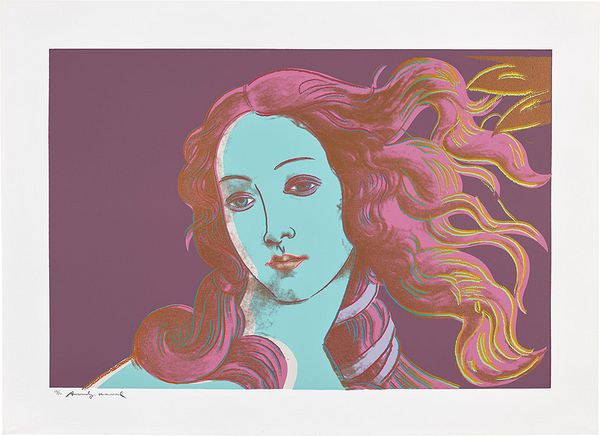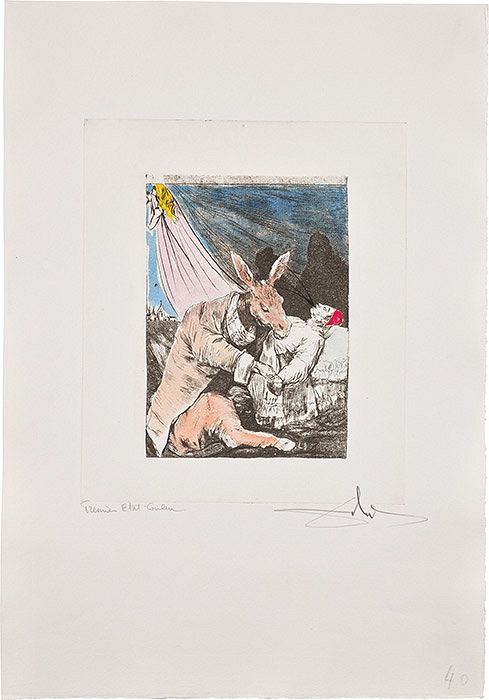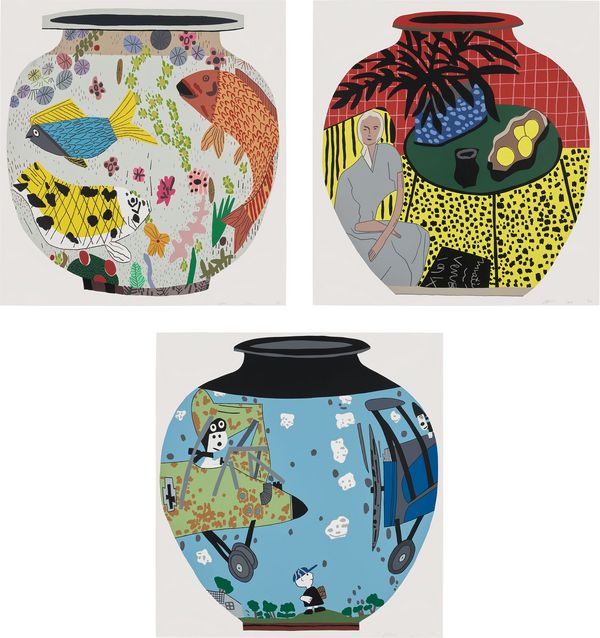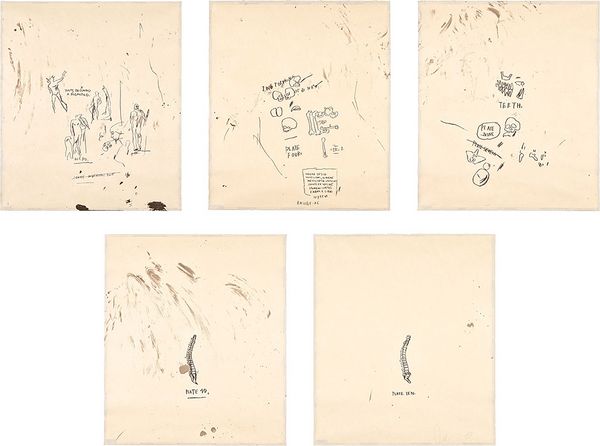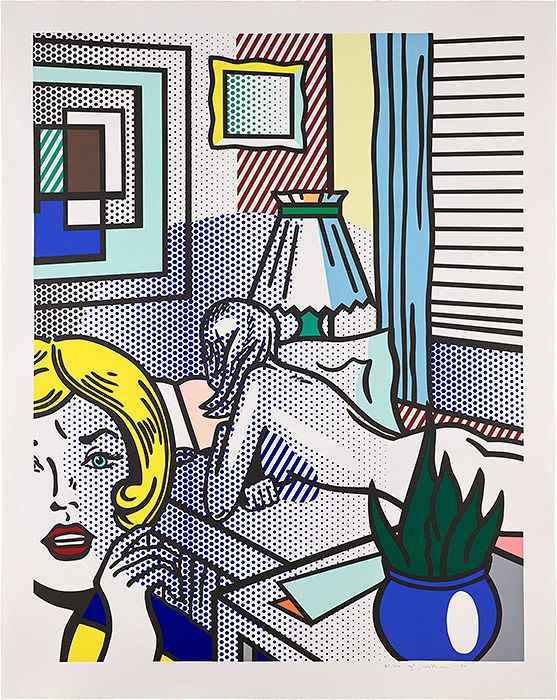Andy Warhol, Details of Renaissance Paintings (Sandro Botticelli, Birth of Venus, 1482), 1984, screenprint. Editions & Works on Paper.
The more art you see, the more you start to appreciate the endless conversations firing back and forth between the masterpieces at the museum. Here, we look at six prints in our upcoming Editions & Works on Paper auctions on 16–17 April that explicitly reference other artworks. We’re excited to share, because the backstory makes them all the more intriguing.
When Leonardo Da Vinci's Mona Lisa came to New York in the winter of 1963, she was a huge star — and among the first subjects to appear in an Andy Warhol silkscreen on canvas. Decades hence, in 1984, after depicting so many homages to the greatest stars of his era, Warhol embarked on a series of images based on legendary Quattrocento masterpieces. Among the most exciting and popular of these is Details of Renaissance Paintings (Sandro Botticelli, Birth of Venus, 1482), his fabulous reinvention of Botticelli’s world-famous painting in the Uffizi.
With bravura nonchalance, Warhol dispenses with the signature compositional set-up — that monumental sweep of the figure rising from the half shell — to focus instead in on the Roman goddess’s head, shoulders, and majestic, windswept curls. He transforms this likeness into a late 20th century portrait-bust format as gorgeously iconic as Botticelli’s entire masterpiece. The unexpected color combos Warhol employs in all four versions are glaringly at odds with Botticelli’s pristine naturalism. She is nonetheless every bit as divinely beautiful in each. Part of the thrill is that, despite Warhol's Pop makeover, we recognize the Goddess of Love as though we have known her forever.
Salvador Dali, Les Caprices de Goya de Dali (Dali's 'Caprichos' by Goya), 1977, ten heliogravures with extensive hand-coloring. Editions & Works on Paper.
In Salvador Dali’s Les Caprices de Goya series, the Surrealist master reworks heliogravure reproductions of Goya’s Caprichos album of 80 black and white prints circa 1797–1798 with his own irrepressibly additions in drypoint and hand-coloring in these early proofs. In Goya's original prints, the artist had surfaced currents deep within the human heart and mind to shed light on the hard truths of his time. He originally suspended publication of the prints for fear of the Inquisition. It was all just too dark and dangerous for him. Dali, by contrast — a celebrant of the unreality of the human unconscious and a mischievous provocateur of epic bravado — dispels their strict and solemn gravitas, making these images of sheer madness all the more outspoken and intense. Oh what fun!
As is evident from the selection of ten prints featured in our sale, the works give rise to a flurry of inspired fantastical conceits. Is Dali channeling Goya? Is it a true collaboration? Or is Dali merely engaging the legendary Baroque genius of yore in a furtive game of one-sided repartee? Happily, the synergy between old and new passages feels cogent. Dali's additions are thoughtful and inspired and calculated to impart a lucid vibrancy that is unexpected, otherworldly, and magical — and Dali and Goya are like dolphins playing across the centuries.
Jonas Wood, Fish Pot; Matisse Pot 4; Snoopy Pot, 2019–2020, three screenprints. Editions & Works on Paper.
Hugely popular Los Angeles artist Jonas Wood has developed a recognizable style that is flat, graphic, and pop — and, at the same time, resoundingly familiar, intimate, and domestic. A painter’s painter, who exploded onto the scene nearly two decades ago with a succession of dynamite shows in LA and New York, he’s influenced by many of the Modern masters, including Matisse and David Hockney in a very big way.
The prints Fish Pot; Matisse Pot 4; Snoopy Pot are coveted exemplars of his oeuvre. Wood acknowledges that the pot forms he recurrently features in his work are nods to his wife, Japanese ceramic artist Shio Kusaka. The two share a studio and have exhibited together. The decorative motifs that bring them to life are his own inspirations. The Japanese koi swimming, the woman seated inside an homage to Matisse, and the Snoopy piloting twin biplanes are less literal copies than elaborate reworkings of source material. Notably, Wood works through his complicated explorations of space and color through collages of photographs of his own life, stuff, and friends, drawings, paintings, and prints — and he combines imagery and influences with meticulous non-hierarchical equanimity. His many visual quotes are typically tantalizing. In the end, one is left to marvel at his spectacular success in harmonizing such stylistically diverse source material.
Jean-Michel Basquiat, Untitled (from Leonardo), 1983, five screenprints. Editions & Works on Paper.
Jean-Michel Basquiat’s Untitled (from Leonardo), 1983 is a series of five screenprints based on the artist’s drawings of Leonardo da Vinci’s anatomical studies. The human body and anatomy frequently appear in Basquiat's works and he often used books as his primary source. When Basquiat was just seven, he was hit by a car playing in the street. In the hospital, his mother brought him a copy of Gray’s Anatomy. The book would later become a huge influence on his artmaking — and, from there, it's only natural he would eventually find his way to Leonardo’s extraordinary anatomical studies.
Basquiat allegedly set upon the idea of doing a print based on the work of da Vinci after gallerist Fred Hoffman learned of his interest and lent him some books about the Renaissance polymath. To accomplish these screenprints, Basquiat drew on acetate sheets, which he left scattered about on the unkempt floor of his studio for several weeks. Hoffman observed that Basquiat's plan was to impart a patina from the stray marks and scuffs they'd invariably receive that would make them look as ancient as Leonardo’s original drawings — all the while serving as a testament to the authenticity of his own lived experience. The final prints, in this sense, are like paper made flesh: Basquiat is able to infuse Leonardo's studies and his own drawings with the raw, palpable intensity of his own corporeal reality.
Roy Lichtenstein, Roommates, from Nudes Series, 1994, monumental relief print in colors. Editions & Works on Paper.
In the last major series of his phenomenal career, Pop art giant Roy Lichtenstein circles back to his beloved comic books nearly 40 years after he began quoting them directly in the late 1950s. But, when he gets to the Nudes Series in the mid 1990s, the comic book style of his art is more famous and recognizable to the museum-going public than the original illustrations themselves. Indeed, these late monumental relief prints resemble Lichtensteins because they are “Lichtensteins.” In this series, he is explicitly quoting himself.
Roommates re-presents the same female protagonists, sourced from "love" and "girl" comic book illustrations, only now embracing the art historical canon of the reclining nude. Yes, the first time Lichtenstein presented nude figures in print! All the while, Lichtenstein spliced plants, curtains and lamps into the composition, reminiscent of his earlier Interiors series. He now allows his Ben-Day dot motifs to undulate in fields freely over multiple forms — and, liberated from their strictly descriptive function, they become more purely iconic. Thus the Nude Series is a daring and revolutionary last chapter, in which Lichtenstein takes it all apart and puts it back together again from the ground up, down to his pictorial language itself.
Marcel Duchamp, Mariée (Bride), 1934, aquatint in colors. Editions & Works on Paper.
Marcel Duchamp and his brother Jacques Villon printed the aquatint Mariée (Bride) in 1934 after an earlier Duchamp painting of 1912 that is reminiscent of the artist’s notorious Nude Descending a Staircase (no. 2), painted in that same year. Notably, she is also the same bride who appears in The Bride Stripped Bare by Her Bachelors, Even, 1915–23, currently in the Philadelphia Museum of Art. Duchamp often revisited themes over the years and repeated works. His La Boîte-en-valise (Box in a Suitcase), 1935–41, for example, reproduces many earlier works in his repertoire and is celebrated as a treasury of original readymades.
In quoting an earlier of his works here, Duchamp underscores the conceptual nature of his moves. The conceit is further reinforced in this print by the stamp in the lower right margin, which appears on only the 20 special impressions of the print and not the larger run of 200. The artist was an avid chess player, and the piece depicted here, a knight, stands in this context as an emblem of strategic finesse in the game of art, making the dry Duchampian wit of the composition resonate all the more.
Recommended Reading
Photographs from the Martin Z. Margulies Foundation >
